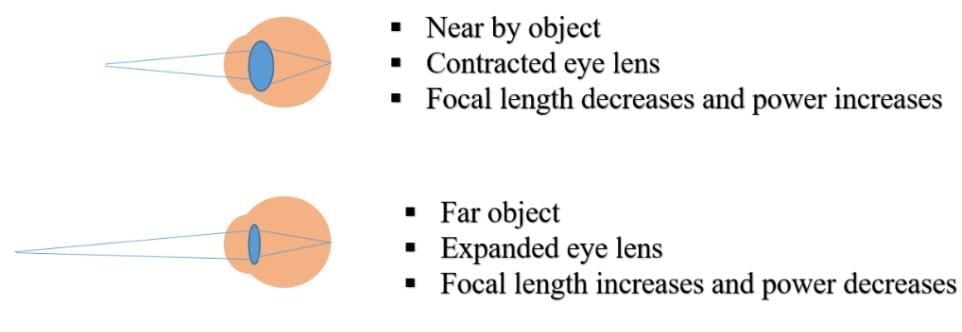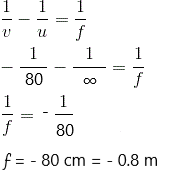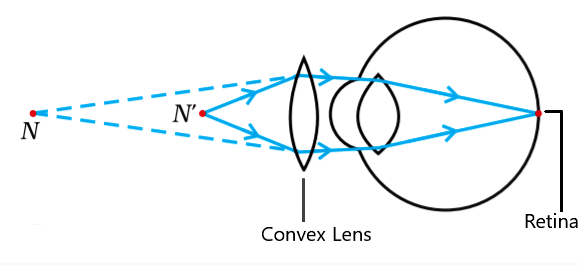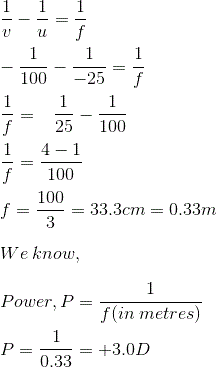NCERT Solutions for Class 10 Science Chapter 10 - Human Eye and Colourful World
Page No. 164
Q1. What is meant by power of accommodation of the eye?
Ans: The ability of the lens of the eye to adjust its focal length to clearly focus rays coming from distant as well from a near objects on the retina, is known as the power of accommodation of the eye.
Q2. A person with a myopic eye cannot see objects beyond 1.2 m distinctly. What should be the type of the corrective lens used to restore proper vision?
Ans: The person is able to see nearby objects clearly, but he is unable to see objects beyond 1.2 m. This happens because the image of an object beyond 1.2 m is formed in front of the retina and not on the retina, as shown in the given figure.
 Myopic Eye
Myopic Eye
To correct this defect of vision, he must use a concave lens. The concave lens will bring the image back to the retina as shown in the given figure.
 Correction of Myopic Eye
Correction of Myopic Eye
Q3. What is the far point and near point of the human eye with normal vision?
Ans: The near point of the eye is the minimum distance of the object from the eye, which can be seen distinctly without strain. For a normal human eye, this distance is 25 cm.
The far point of the eye is the maximum distance to which the eye can see the objects clearly. The far point of the normal human eye is infinity.
Q4. A student has difficulty reading the blackboard while sitting in the last row. What could be the defect the child is suffering from? How can it be corrected?
Ans: A student has difficulty reading the blackboard while sitting in the last row. It shows that he is unable to see distant objects clearly. He is suffering from myopia. This defect can be corrected by using a concave lens.
Page No. 170
Exercises
Q1. The human eye can focus objects at different distances by adjusting the focal length of the eye lens. This is due to
(a) presbyopia
(b) accommodation
(c) near-sightedness
(d) far-sightedness
Ans: (b) accommodation
Human eye can change the focal length of the eye lens to see the objects situated at various distances from the eye. This is possible due to the power of accommodation of the eye lens.
Q2. The human eye forms the image of an object at its
(a) cornea
(b) iris
(c) pupil
(d) retina
Ans: (d) retina
The retina is the layer of nerve cells lining the back wall inside the eye. This layer senses light and sends signals to the brain so you can see.
Q3. The least distance of distinct vision for a young adult with normal vision is about
(a) 25 m
(b) 2.5 cm
(c) 25 cm
(d) 2.5 m
Ans: (c) 25 cm
The least distance of distinct vision is the minimum distance of an object to see a clear and distinct image. It is 25 cm for a young adult with normal vision.
Q4. The change in focal length of an eye lens is caused by the action of the
(a) pupil
(b) retina
(c) ciliary muscles
(d) iris
Ans: (c) ciliary muscles
The relaxation or contraction of ciliary muscles changes the curvature of the eye lens. The change in curvature of the eye lens changes the focal length of the eyes. Hence, the change in focal length of an eye lens is caused by the action of ciliary muscles.
Q5. A person needs a lens of power −5.5 dioptres for correcting his distant vision. For correcting his near vision he needs a lens of power +1.5 dioptre. What is the focal length of the lens required for correcting (i) distant vision, and (ii) near vision?
Ans: For distant vision = −0.181 m, for near vision = 0.667 m
The power P of a lens of focal length f is given by the relation
Power (P) = 1 / f(in metres)
(i) Power of the lens used for correcting distant vision = −5.5 D
Focal length of the required lens, f = 1 / p
f = 1 / -5.5 => f= -0.181 m
The focal length of the lens for correcting distant vision is −0.181 m.
(ii) Power of the lens used for correcting near vision = +1.5 D
Focal length of the required lens, f = 1 / p
f = 1 / 1.5 = +0.667 m
The focal length of the lens for correcting near vision is 0.667 m.
Q6. The far point of a myopic person is 80 cm in front of the eye. What is the nature and power of the lens required to correct the problem?
Ans: The person is suffering from an eye defect called myopia. In this defect, the image is formed in front of the retina. Hence, a concave lens is used to correct this defect of vision.
Object distance, u = infinity = ∞
Image distance, v = −80 cm
Focal length = f
According to the lens formula,

We know,

A concave lens of power −1.25 D is required by the person to correct his defect.
Q7. Make a diagram to show how hypermetropia is corrected. The near point of a hypermetropic eye is 1 m. What is the power of the lens required to correct this defect? Assume that the near point of the normal eye is 25 cm.
Ans: A person suffering from hypermetropia can see distinct objects clearly but faces difficulty in seeing nearby objects clearly. It happens because the eye lens focuses the incoming divergent rays beyond the retina. This defect of vision is corrected by using a convex lens. A convex lens of suitable power converges the incoming light in such a way that the image is formed on the retina, as shown in the following figure.
 Correction of Hypermetropic EyeThe convex lens actually creates a virtual image of a nearby object (N’ in the figure) at the near point of vision (N) of the person suffering from hypermetropia.
Correction of Hypermetropic EyeThe convex lens actually creates a virtual image of a nearby object (N’ in the figure) at the near point of vision (N) of the person suffering from hypermetropia.
The person will be able to clearly see the object kept at 25 cm (near point of the normal eye) if the image of the object is formed at his near point, which is given as 1 m.
Object distance, u = −25 cm
Image distance, v = −1 m = −100 cm
Focal length, f
Using the lens formula,

A convex lens of power +3.0 D is required to correct the defect.
Q8. Why is a normal eye not able to see clearly the objects placed closer than 25 cm?
Ans: A normal eye is unable to clearly see the objects placed closer than 25 cm because the ciliary muscles of eyes are unable to contract beyond a certain limit.
If the object is placed at a distance less than 25 cm from the eye, then the object appears blurred and produces strain in the eyes.
Q9. What happens to the image distance in the eye when we increase the distance of an object from the eye?
Ans: Since the size of the eyes cannot increase or decrease, the image distance remains constant. When we increase the distance of an object from the eye, the image distance in the eye does not change. The increase in the object distance is compensated by the change in the focal length of the eye lens. The focal length of the eyes changes in such a way that the image is always formed on the retina of the eye.
Q10. Why do stars twinkle?
Ans: Stars twinkle due to atmospheric refraction of starlight. As the stars are very far away, they behave almost like point sources of light. As on account of atmospheric refraction, the path of rays of light coming from the star goes on varying slightly, the apparent position of the star fluctuates and the amount of light entering the eye flickers, so sometimes the star appear brighter and at some other time, fainter. Thus the stars twinkle.
Q11. Explain why the planets do not twinkle?
Ans: Planets are much closer to the earth and are seen as extended sources. So, a planet may be considered as a collection of a large number of point-sized light sources. Although light coming from individual point-sized sources flickers but the total amount of light entering our eye from all the individual point-sized sources average out to be constant. Thereby, planets appear equally brighter and there is no twinkling of planets.
Q12. Why does the sky appear dark instead of blue to an astronaut?
Ans: The blue colour of the sky is due to the scattering of shorter wavelength light by air molecules in the Earth’s atmosphere. If the earth had no atmosphere, there would not have been any scattering and sky would have looked dark. When astronaut in his spacecraft goes above the atmosphere of earth, sky appears dark to him because there is no scattering of light.
|
80 videos|662 docs|80 tests
|
FAQs on NCERT Solutions for Class 10 Science Chapter 10 - Human Eye and Colourful World
| 1. What is the structure of the human eye? |  |
| 2. How does the human eye perceive color? |  |
| 3. What is the role of the lens in the human eye? |  |
| 4. How does the human eye adapt to different lighting conditions? |  |
| 5. How does the optic nerve transmit visual information to the brain? |  |






















